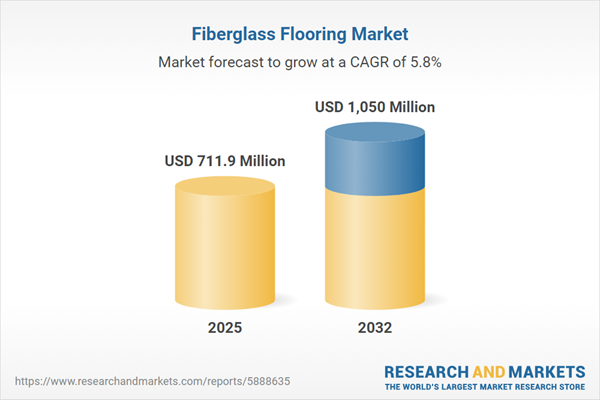Speak directly to the analyst to clarify any post sales queries you may have.
The fiberglass flooring market offers senior decision-makers a strong platform for operational flexibility, compliance, and sustained value. With durable, adaptive solutions, it supports organizations navigating shifts in facility requirements, procurement models, and long-term asset strategies.
Market Snapshot: Fiberglass Flooring Market Size and Growth Outlook
The global fiberglass flooring market is expected to expand from USD 673.36 million in 2024 to USD 711.90 million in 2025, reflecting a compound annual growth rate (CAGR) of 5.82%. This growth is accelerated by steady demand linked to both new construction projects and global renovation trends. Organizations are increasingly turning to fiberglass flooring due to its high resistance to wear, performance in challenging operational environments, and compatibility with evolving portfolio needs. Leaders across the commercial, industrial, and residential sectors continue to leverage its strengths in durability, low maintenance, and adaptability. This dynamic is fueling procurement opportunities and enabling diversification strategies for buyers in a range of geographies and industries.
Scope & Segmentation: Key Dimensions Shaping Procurement in the Fiberglass Flooring Market
The sector’s diverse solutions are tailored to a variety of procurement and operational requirements. Key segmentation and strategic elements include:
- Resin Types: Choices such as epoxy, polyester, and vinyl ester influence installation ease, long-term performance, and resistance to environmental exposure. Careful selection helps teams match materials to project specifications and maintain quality standards.
- Installation Types: Options for both new construction and renovation projects enable seamless facility integration while supporting modernization of existing structures.
- Price Tiers: A spectrum from economy to premium tiers lets procurement teams align purchasing with organizational budget constraints and performance expectations.
- End-Use Industries: Applications span offices, hospitality, manufacturing, warehouses, and residential buildings, underscoring flexibility and broad utility in distinct operating conditions.
- Applications: Modular formats like planks, sheets, and tiles allow for precise adaptation to technical standards and branding requirements in varied project contexts.
- Distribution Channels: Availability through direct purchasing, distributor partnerships, manufacturers’ digital platforms, and top e-commerce options streamlines logistics and supports consistent supply.
- Regions: Operations extend across the Americas, Europe, Middle East & Africa, and Asia-Pacific, addressing localized compliance, transportation, and regulatory needs.
- Key Regional Markets: The United States, Canada, China, India, Brazil, Germany, United Kingdom, United Arab Emirates, and Japan are focal points, each operating within unique regulatory frameworks that affect sourcing strategies and end-use applications.
- Major Companies: Established players such as Owens Corning, Hexcel Corporation, PPG Industries, Ashland Global Holdings, SGL Carbon SE, Gurit Holding AG, TenCate Advanced Composites BV, Asahi Kasei Corporation, Strongwell Corporation, and Fibergrate Composite Structures anchor sourcing and supply relationships for buyers.
Key Takeaways for Senior Decision-Makers
- Emerging resin formulations and updated installation techniques are raising the bar for performance, opening new uses for fiberglass flooring in demanding venues.
- Lower routine maintenance translates into streamlined facility management, reducing unplanned downtime and supporting predictable operating schedules.
- Adoption of sustainable practices, such as bio-based resins and circular production, aligns with environmental policies and supports evolving compliance requirements.
- Procurement approaches must stay agile in response to diverse, shifting regulations across countries and regions, reinforcing the need for localized knowledge and ongoing policy assessment.
- Comprehensive channel choices in procurement and distribution strengthen project resilience and offer flexibility to address logistics or supply risks.
- Enhanced digital procurement tools improve access to technical specifications, enabling rapid, informed decisions for organizations managing sites in multiple locations.
Tariff Impact: U.S. Trade Policy and Supply Chain Risk
New tariffs affecting fiberglass flooring and components have added complexity for U.S. procurement teams. In response, supply chain managers are expanding their supplier base and refining sourcing strategies to maintain reliability, control costs, and address heightened compliance requirements.
Methodology & Data Sources
This analysis combines comprehensive secondary research, executive interviews, and input from project management professionals. Quantitative modeling is used to enhance qualitative insights, ensuring the findings remain robust and actionable for senior stakeholders.
Why This Report Matters
- The report delivers applied segmentation and focused recommendations, helping procurement teams minimize risk in the fiberglass flooring sector.
- Focus areas include technology integration, navigating regulatory complexity, and building sustainable sourcing practices that adapt to shifting market conditions.
- Executive leaders gain anticipatory guidance to navigate future sector changes, reinforcing the ability to respond swiftly and strategically.
Conclusion
Senior executives can enhance their procurement and supply chain resilience by aligning strategy with current policy, technology, and sustainability trends. The report serves as a decision-support resource for optimizing operations in the fiberglass flooring market.
Additional Product Information:
- Purchase of this report includes 1 year online access with quarterly updates.
- This report can be updated on request. Please contact our Customer Experience team using the Ask a Question widget on our website.
Table of Contents
3. Executive Summary
4. Market Overview
7. Cumulative Impact of Artificial Intelligence 2025
Companies Mentioned
The companies profiled in this Fiberglass Flooring market report include:- Owens Corning
- Hexcel Corporation
- PPG Industries, Inc.
- Ashland Global Holdings, Inc.
- SGL Carbon SE
- Gurit Holding AG
- TenCate Advanced Composites BV
- Asahi Kasei Corporation
- Strongwell Corporation
- Fibergrate Composite Structures, Inc.
Table Information
| Report Attribute | Details |
|---|---|
| No. of Pages | 189 |
| Published | October 2025 |
| Forecast Period | 2025 - 2032 |
| Estimated Market Value ( USD | $ 711.9 Million |
| Forecasted Market Value ( USD | $ 1050 Million |
| Compound Annual Growth Rate | 5.8% |
| Regions Covered | Global |
| No. of Companies Mentioned | 11 |









